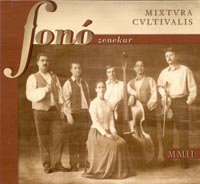
Anyone knowledgable of the subject is well aware that folksongs are a more than thousand-year-old integral part of our cultural heritage which evoke the traditions of our ancestors in their pristine glory, bestowing upon us a certain sense of responsibility; forthose who have no history shall neither have any future .
The primal force flowing from this pure and untainted well provides direction to the devoted members of subsequent generations who hold in great respect the wisdom of tradition and seek to further deepen this well. Yet, others have posed the question of how folk music , with its long-forgotten, static and archaic aesthetical aspect and overall incapacity for renewal – might be integrated into this modernised, bustling and forceful information age where, as the manifestation of freedom, the inclination towards personal selection of an identity shape the masses empowered and primed by the force of social regeneration, an age where this socio-cultural transition is permeated by a super-advanced and progressive idealism . . .”
When it comes to folk music, much can be heard.
Nonetheless, these very songs, melodies and compositions preserved on this recording were all compiled and drawn from people living and working in this very same age and in this very same and indivisible world.
To put it another way :
This very power is here and now becoming a part of us
The lasting impressions of those branches of art which were influence by trends and concepts and presumptuously consider by some to be more advanced and modern, at the moment of their conception predetermined, canonized and copyrighted the modes of technical recording/presentation – in essence the only valid, exclusively authorized version of the work for public consumption. In contrast, those branches of art born in the realm of oral tradition are by virtue of their inherent nature capable of constant change and transformation. In this art form it is not a question of what but of how . For here too, there are unwritten, complex rules governing the style and manner of performance and presentation, however, within these confines all participants are free to express themselves as they choose; each community and each individual is able to shape and customize the substance of his culture. This perhaps serves as the explanation for the diversity, variability and colorfulness folk music. The following poetic analogy holds exceptionally true for the world of folklore: “The landscape seems but a map for those who view it from a plane” – for the exuberant richness of folklore is little perceptible from a distance. The title of our record declares this multi-facetedness and expresses the need and the objectives of the conscious and deliberate cultivation of this cultural polyphony. The expression of our characteristic uniqueness stems from the cultivation of this rich, authentic and complex heritage.
To put it another way: :
MIXTURA CULTIVALIS
1. Oh, secret love (Folk song from Magyarbőd)…………………………………………… … 1'54”
2.
It begins secretly (Csárdás from Magyarbőd )………………………………………………4'15”
3.
So that I don't need paint on my cheeks (Lament and „Hungarian” from Magyarszovát)……5'48”
4.
On the corner of her rosemary pillow (Dawn song and lads' dance from Kalotaszeg)………6'17”
5.
Three nights, three days (Csárdás and swift from Kalotaszeg)………………………………5'03”
6.
Memory of Josko Kura (Bagpipe songs form Zoborvidék)……………………………… … 5'11”
7.
The wheat must grow ripe (Gypsy dance and „orphan song” from Nyirvasvári)……………..8'07”
8.
I lost my horse (Shepherds' songs for stick dance from Gömör)……………………… … ….7'14”
9.
When I go out to the hill in Daróc (“Hallgató” and melodies from Nagydaróc)……………. 5'46”
10.
„Whose soul is wine” (Drinking songs from Bodrogköz)…………………………………..2'28”
11.
My sweetheart, you took my sense away (“Oláhos”, csárdás and „fogás” from Bodrogköz)..7'49”
12.
Tears of women (Ruthenian chorovods from Sáros)…………………………………… … .4'43”
13.
Huculka (Ruthenian music from Técső)…………………………………………………… 5'40”
14.
In memoriam Bohumil Hrabal (Wedding march from Jóka)………………………………2'17”
Total time…………………………………………………………………………….69'32''
Fonó Folk Band:
Ágnes Herczku – vocals (1a, 2,3b, 5,7b, 8a)
Gergely Agócs – vocals (1a, 3a, 4, 5, 6a, 7a), flute (2), bagpipe (4), tárogató (6b)
Tamás Gombai – vocals (1a), violin (1b, 3a-b, 4, 6a-b, 7b, 8b, 9)
Gábor Szabó – vocals (1a), violin (1b, 3a-b, 6a-b, 7b, 9)
Sándor D. Tóth – vocals (1a), second violin (6a, 9), viola (1b, 3a-b, 6a-b, 7b), guitar (5), drum (8b)
Zsolt Kürtösi – vocals (1a), double-bass (1b, 3a-b, 6b, 7b, 9), accordion (8b)
With the contribution of:
Balázs Unger – dulcimer (1b, 6a-b, 7b), little dulcimer (8b)
Vándor Vokál band:
Katalin Bakó – vocals (8a)
Szilvia Bognár – vocals (8a)
Tünde Farkaš – vocals (8a)
Katalin Izsák – vocals (8a)
Ágnes Szalóki – vocals (5)
Adrienn Buzássy – vocals (5)
Júlia Zsákay – volcals (5)
Ádám Pettik – water can, oral bass (5)